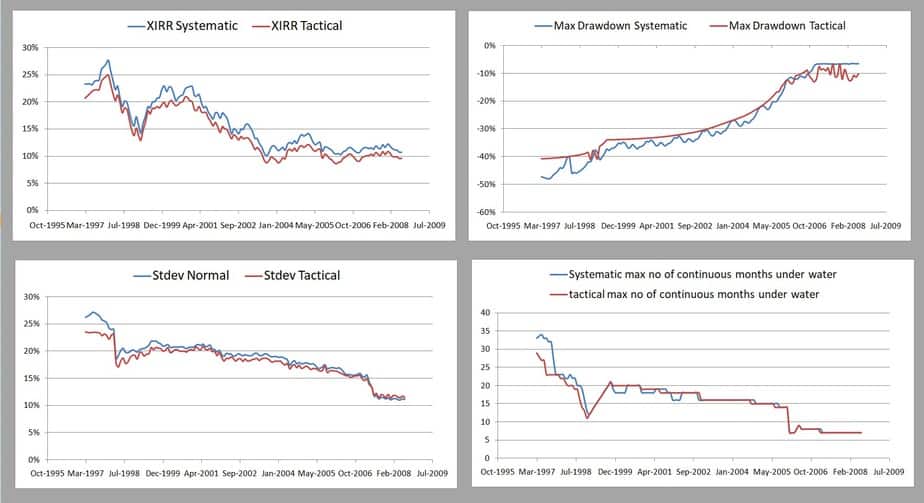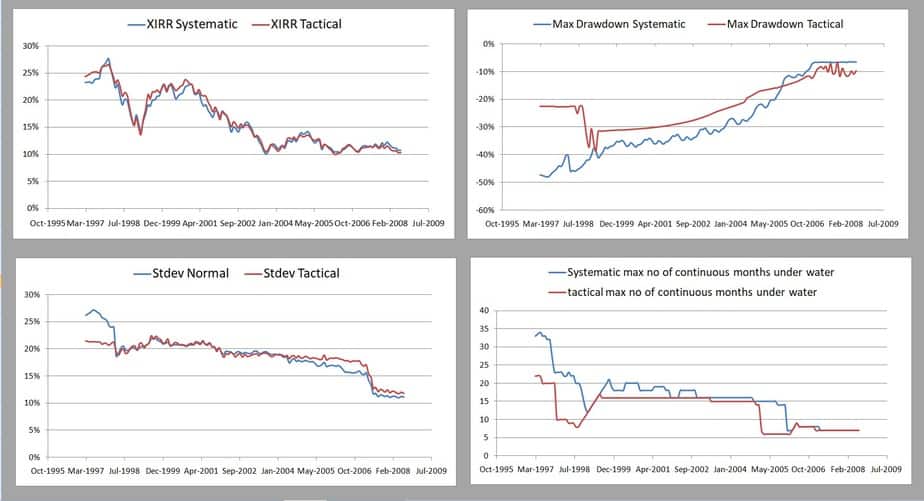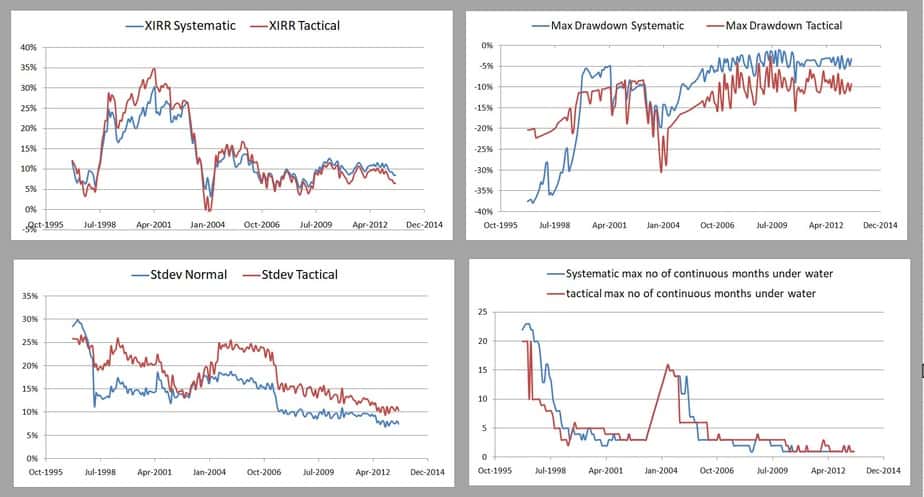Last Updated on December 29, 2021 at 11:47 am
As pointed out yesterday, many investors get nervous when the market hits all-time highs on a daily basis and start asking “should I book profits now and re-enter later?”. Sadly, they only talk about the exit mark and have no idea when they would re-enter. It amounts to a random thought often influenced by what they read, with no plan in mind (if they had one, they will not be asking). In this post, I discuss the effect of some market timing strategies based on market all-time highs.
If the market falls as you are reading this, blame it on the commentator’s curse (batsmen getting out when commentators talk about how well they are playing)! First, let us take a look at the Sensex.
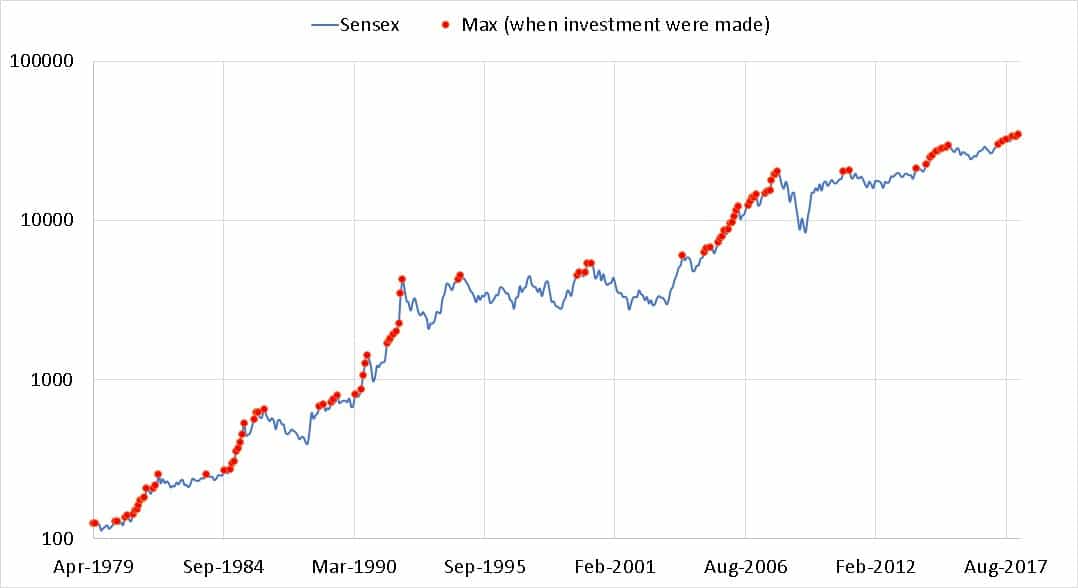
So the red dots represent all-time highs. The Sensex is shown here in log scale. To understand the benefit of using log scale is see: Are you ready to climb the Sensex Staircase?! Most all-time highs are followed by further all-time highs. So to assume that the market will crash just because there is an all-time high is plain childish. Of course, one can ask, we find out at which all-time high the market is likely to crash? We will consider that in the next part of this series. Readers may recall that the above graph is part of this study: When the market is at an all-time high, how should a lump sum be invested? One-shot or gradually?
Join 32,000+ readers and get free money management solutions delivered to your inbox! Subscribe to get posts via email! (Link takes you to our email sign-up form)
🔥Want to create a complete financial plan? Learn goal-based investing? Exclusive access to our DIY tools? Increase your income with your skills? Enjoy massive discounts on our robo-advisory tool & courses! 🔥
In this post, three types of profit booking (remove some equity portion) when the market is at an all-time high. You are likely to dismiss them as silly and involving too much work. I agree, but it is better to counter “should I book profit now since the market is at an all-time high” with data than opinions
Method 1: Invest systematically each month. Observe the value of the index or the NAV of a mutual fund indexed to the market. If current NAV or price is the all-time high, then rebalance the portfolio back to 70% equity and 30% debt (70:30) or to 50% equity and 50 debt (50:50). If the current NAV or price < all-time-high then do nothing.
Method 2: Invest systematically each month. Observe the value of the index or the NAV of a mutual fund indexed to the market. If current NAV or price is the all-time high, then rebalance only if equity is above 70% or 50%. If current NAV or price is < all-time-high, then rebalance only if equity less than 70% or 50%.
That is, when we hold excessive equity when the market is at an all-time, we book profit. If we hold less equity when the market is away from an all-time high, we add more equity.
Method 3: Invest systematically each month. If current NAV or price is the all-time high, then redeem 10% equity if the equity allocation is >40%. If current NAV or price < all-time-high then shift 10% debt to equity if debt allocation is > 20%.
The rules of the game are the same as all other tactical asset allocation posts. You can refer to the latest: Market Timing with the Motilal Oswal Value Index (MOVI) We use Franklin India Blue Chip Fund for the Equity component and
Method 1 (rebalance at each all-time high): Period = 10 years; Equity = 50% Fixed Income = 50%
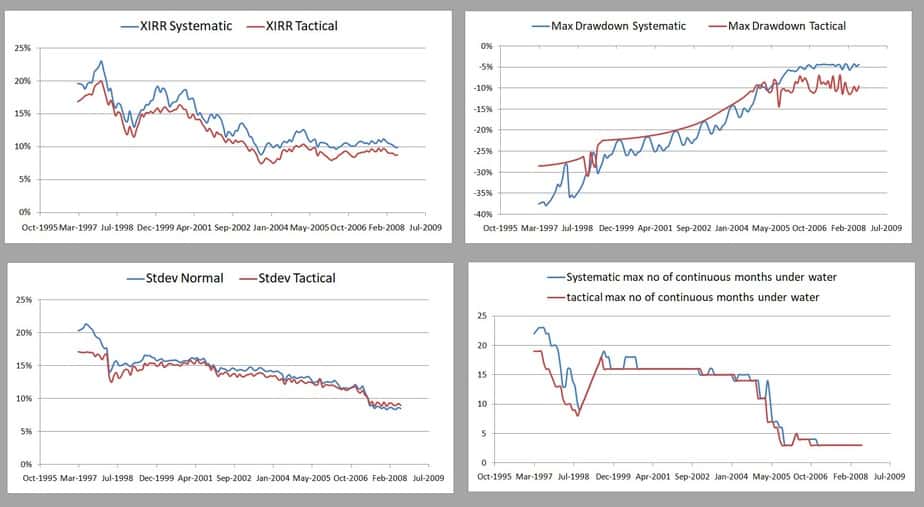
Top Left: The XIRR or returns are compared. Higher the better! XIRR tactical refers to method 1/2/3.
Top Right: The maximum fall of the portfolio from a peak is compared. The vertical axis is negative. So lower the value, the more the fall, the more the risk.
Bottom left: Standard deviation or how much the monthly returns fluctuate is compared. Higher the value, the higher the fluctuation, the higher the risk.
Bottom right: The no of months, the portfolio was continuously lower than a previous peak (underwater) is compared. Higher the no of months, higher the risk.
Method 1 (rebalance at each all-time high): Period = 10 years; Equity = 70% Fixed Income = 30%
Method 2 (rebalance only excess equity at all-time highs): Period = 10 years; Equity = 50% Fixed Income = 50%
Method 2: Period = 10 years; Equity = 70% Fixed Income = 30%
Method 3 (book 10% profit at all-time highs): Period = 10 years; Equity = 50% Fixed Income = 50%
Method 3: Period = 10 years; Equity = 70% Fixed Income = 30%
Method 3 (book 10% profit at all-time highs): Period = 5 years; Equity = 50% Fixed Income = 50%
Summary
Wait. Did you scroll down all the way here ignoring the graphs just to see “if there is a clear message about what to do when the market is at an all-time high”? Then shame on you. If you took the time to view the graphs then, thank you.
Out of the methods tested, it should be clear (for those who bothered to stop and stare) that method 3 is relatively the most productive for the 50:50 case. However, are you willing book 10% of your equity or debt portfolio pretty much each month? It is not enough if you are “scared” about “all-time-highs”. Do you have the enterprise to come up with a plan? Do you have the will to execute? Do you the have the discipline to stick to it? If not, invest systematically and rebalance once a year with gradual goal-based equity reduction and forget about market-highs.
For the record, if you wish to time the market, there are many other methods available that involve less activity. Since we cannot say for sure if a timing model will produce higher returns than a systematic approach, two requirements are essential: the number of buy/sells should be minimized else too much will be lost to tax and loads. The volatility or at least the ma fall should be lower in the timing model (unless it designed to be a higher-risk approach). Although the quantum of buying and selling is lower in this all-time approach, the number of such events are too frequent (at least twice each quarter , if not each month).
To get something, you need to either do something or lose something. Random opinions (such as this post) will not help. Sadly most investors neither know what they want to get, let alone doing something or losing something. Sigh!
🔥Enjoy massive discounts on our courses, robo-advisory tool and exclusive investor circle! 🔥& join our community of 7000+ users!
Use our Robo-advisory Tool for a start-to-finish financial plan! ⇐ More than 2,500 investors and advisors use this!
Track your mutual funds and stock investments with this Google Sheet!
We also publish monthly equity mutual funds, debt and hybrid mutual funds, index funds and ETF screeners and momentum, low-volatility stock screeners.





- Do you have a comment about the above article? Reach out to us on Twitter: @freefincal or @pattufreefincal
- Have a question? Subscribe to our newsletter using the form below.
- Hit 'reply' to any email from us! We do not offer personalized investment advice. We can write a detailed article without mentioning your name if you have a generic question.
Join 32,000+ readers and get free money management solutions delivered to your inbox! Subscribe to get posts via email! (Link takes you to our email sign-up form)
About The Author
 Dr M. Pattabiraman(PhD) is the founder, managing editor and primary author of freefincal. He is an associate professor at the Indian Institute of Technology, Madras. He has over ten years of experience publishing news analysis, research and financial product development. Connect with him via Twitter(X), Linkedin, or YouTube. Pattabiraman has co-authored three print books: (1) You can be rich too with goal-based investing (CNBC TV18) for DIY investors. (2) Gamechanger for young earners. (3) Chinchu Gets a Superpower! for kids. He has also written seven other free e-books on various money management topics. He is a patron and co-founder of “Fee-only India,” an organisation promoting unbiased, commission-free investment advice.
Dr M. Pattabiraman(PhD) is the founder, managing editor and primary author of freefincal. He is an associate professor at the Indian Institute of Technology, Madras. He has over ten years of experience publishing news analysis, research and financial product development. Connect with him via Twitter(X), Linkedin, or YouTube. Pattabiraman has co-authored three print books: (1) You can be rich too with goal-based investing (CNBC TV18) for DIY investors. (2) Gamechanger for young earners. (3) Chinchu Gets a Superpower! for kids. He has also written seven other free e-books on various money management topics. He is a patron and co-founder of “Fee-only India,” an organisation promoting unbiased, commission-free investment advice.Our flagship course! Learn to manage your portfolio like a pro to achieve your goals regardless of market conditions! ⇐ More than 3,000 investors and advisors are part of our exclusive community! Get clarity on how to plan for your goals and achieve the necessary corpus no matter the market condition is!! Watch the first lecture for free! One-time payment! No recurring fees! Life-long access to videos! Reduce fear, uncertainty and doubt while investing! Learn how to plan for your goals before and after retirement with confidence.
Our new course! Increase your income by getting people to pay for your skills! ⇐ More than 700 salaried employees, entrepreneurs and financial advisors are part of our exclusive community! Learn how to get people to pay for your skills! Whether you are a professional or small business owner who wants more clients via online visibility or a salaried person wanting a side income or passive income, we will show you how to achieve this by showcasing your skills and building a community that trusts and pays you! (watch 1st lecture for free). One-time payment! No recurring fees! Life-long access to videos!
Our new book for kids: “Chinchu Gets a Superpower!” is now available!


Must-read book even for adults! This is something that every parent should teach their kids right from their young age. The importance of money management and decision making based on their wants and needs. Very nicely written in simple terms. - Arun.Buy the book: Chinchu gets a superpower for your child!
How to profit from content writing: Our new ebook is for those interested in getting side income via content writing. It is available at a 50% discount for Rs. 500 only!
Do you want to check if the market is overvalued or undervalued? Use our market valuation tool (it will work with any index!), or get the Tactical Buy/Sell timing tool!
We publish monthly mutual fund screeners and momentum, low-volatility stock screeners.
About freefincal & its content policy. Freefincal is a News Media Organization dedicated to providing original analysis, reports, reviews and insights on mutual funds, stocks, investing, retirement and personal finance developments. We do so without conflict of interest and bias. Follow us on Google News. Freefincal serves more than three million readers a year (5 million page views) with articles based only on factual information and detailed analysis by its authors. All statements made will be verified with credible and knowledgeable sources before publication. Freefincal does not publish paid articles, promotions, PR, satire or opinions without data. All opinions will be inferences backed by verifiable, reproducible evidence/data. Contact information: To get in touch, use this contact form. (Sponsored posts or paid collaborations will not be entertained.)
Connect with us on social media
- Twitter @freefincal
- Subscribe to our YouTube Videos
- Posts feed via Feedburner.
Our publications
You Can Be Rich Too with Goal-Based Investing
 Published by CNBC TV18, this book is meant to help you ask the right questions and seek the correct answers, and since it comes with nine online calculators, you can also create custom solutions for your lifestyle! Get it now.
Published by CNBC TV18, this book is meant to help you ask the right questions and seek the correct answers, and since it comes with nine online calculators, you can also create custom solutions for your lifestyle! Get it now.Gamechanger: Forget Startups, Join Corporate & Still Live the Rich Life You Want
 This book is meant for young earners to get their basics right from day one! It will also help you travel to exotic places at a low cost! Get it or gift it to a young earner.
This book is meant for young earners to get their basics right from day one! It will also help you travel to exotic places at a low cost! Get it or gift it to a young earner.Your Ultimate Guide to Travel
 This is an in-depth dive into vacation planning, finding cheap flights, budget accommodation, what to do when travelling, and how travelling slowly is better financially and psychologically, with links to the web pages and hand-holding at every step. Get the pdf for Rs 300 (instant download)
This is an in-depth dive into vacation planning, finding cheap flights, budget accommodation, what to do when travelling, and how travelling slowly is better financially and psychologically, with links to the web pages and hand-holding at every step. Get the pdf for Rs 300 (instant download)